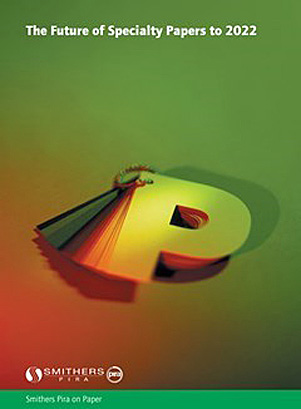Rapid Technology Changes Drive Speciality Papers Market

The speciality paper industry is changing as fast as the markets are moving. New machinery and technology is entering the markets, as the commodity printing and writing market went through rapid decline and now is slowly shrinking in the developed countries. This will tend to disrupt the speciality papermakers, as new technology will enable faster and wider machines to effectively and economically produce more technical speciality grades.
Smithers Pira’s latest report
The Future of Speciality Paper to 2022 projects the global market for speciality papers in 2017 to be 24.16 million metric tons, and forecasts it to reach 26.98 million metric tons in 2022. This represents a CAGR of 2.2% in the five-year period from 2017 to 2022.
"The regulatory environment continues to be complicated, driving changes in materials for health, safety, and sustainability," said Bruce W Janda, author of the report. "Speciality papers enjoy many opportunities for new product development to create new demand. Replacement of plastics with sustainable paper-based materials is a large opportunity. Disruptive technologies are coming into the market to support plastics replacement."
Speciality papers have become even more important because commodity grades used for graphic communications, such as newsprint, freesheet, and coated printing papers, have declined abruptly over the past 10 years in Western Europe and North America. Recent trends suggest that this may also be starting to happen in more recently developed markets such as China. This trend is expected to continue and spread to the other regional markets as digitalization of communications continues. As the global graphic commodity papermaking universe contracts, speciality paper grades are becoming one of the forces for growth in the industry, along with tissue and packaging.
Several key common features of speciality papers are noteworthy. They tend to be higher added-value products due to their unique characteristics. These features often allow speciality producers to charge a premium. Consequently, they are perceived to lead to a better financial performance for the manufacturer. Speciality papers are also seen as useful product portfolio extenders for risk spread over several markets. Often the introduction of speciality papers arises from the availability of, or need to make use of, small-scale output machinery that would otherwise be shut down. The premium charged on the added value allows a producer to work machinery that would otherwise be too costly when making large-scale commodity products, where price competition tends to be fierce.
This report quantifies and segments the specialty paper market globally across 14 major countries and identifies opportunities and threats facing suppliers.
The report was based on an in-depth combination of primary and secondary research. Primary research included telephone interviews used to generate an up-to-date and accurate picture of the market and to gather information on the specialty papers market that is not available from published sources. Secondary research was based on extensive literature analysis of published data and trends collected from leading players.
With expert insight,
The Future of Speciality Papers to 2022 provides a vital strategic planning tool for pulp and paper manufacturers, converters, and equipment manufacturers of specialty papers.
Smithers Pira is a worldwide authority on packaging, paper, and print industry supply chains. Established in 1930, Smithers Pira provides strategic and technical consulting, testing, intelligence, and events to help clients gain market insights, identify opportunities, evaluate product performance, and manage compliance.
More information is available online.
TAPPI
http://www.tappi.org/
 The speciality paper industry is changing as fast as the markets are moving. New machinery and technology is entering the markets, as the commodity printing and writing market went through rapid decline and now is slowly shrinking in the developed countries. This will tend to disrupt the speciality papermakers, as new technology will enable faster and wider machines to effectively and economically produce more technical speciality grades.
The speciality paper industry is changing as fast as the markets are moving. New machinery and technology is entering the markets, as the commodity printing and writing market went through rapid decline and now is slowly shrinking in the developed countries. This will tend to disrupt the speciality papermakers, as new technology will enable faster and wider machines to effectively and economically produce more technical speciality grades.